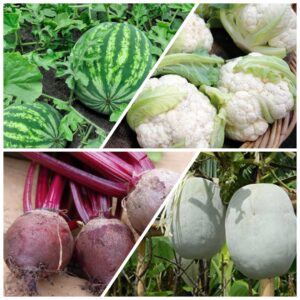- Empty cart.
- Continue Shopping
Cabbage
Original price was: ₹60.00.₹40.00Current price is: ₹40.00.
| Genus: |
Our cabbage vegetable plant seeds are perfect for home gardening enthusiasts. Grow your own delicious and nutritious cabbages, packed with vitamins and antioxidants, for use in salads, stir-fries, and more.
Cabbage is a leafy vegetable plant that belongs to the Brassicaceae family. It is widely grown for its dense, rounded heads of tightly packed leaves. Here are some important points to know about growing cabbage:
1. Climate and soil requirements: Cabbage prefers cool weather and thrives in temperatures between 15-25°C (59-77°F). It grows best in well-drained, fertile soil with a pH range of 6.0-7.5. The soil should be rich in organic matter and have good moisture retention.
2. Planting: Cabbage can be grown from seeds or seedlings. If starting from seeds, sow them indoors 4-6 weeks before the last frost date. Once the seedlings have grown several true leaves, they can be transplanted into the garden. Alternatively, you can directly sow the seeds outdoors after the last frost.
3. Spacing and thinning: Space cabbage plants about 30-45 centimeters (12-18 inches) apart to allow sufficient room for their heads to develop. Thinning may be necessary if the plants are too crowded. Thin the seedlings to the desired spacing, leaving the strongest ones to grow.
4. Sunlight and watering: Cabbage requires full sun exposure for at least 6-8 hours a day. Water the plants regularly to keep the soil evenly moist. Avoid overwatering, as it can lead to root rot. Mulching can help retain soil moisture and regulate temperature.
5. Fertilization: Prior to planting, incorporate well-rotted compost or organic matter into the soil to provide nutrients. Cabbage benefits from a nitrogen-rich fertilizer during its early growth stage. Apply a balanced fertilizer once the plants are established, following the instructions on the packaging.
6. Pest and disease management: Cabbage is susceptible to certain pests like cabbage worms, aphids, and cabbage loopers. Monitor the plants regularly and take appropriate measures to control pests, such as handpicking, applying organic insecticides, or using row covers. Keep an eye out for diseases like clubroot and black rot, and promptly remove affected plants to prevent the spread.
7. Harvesting: Cabbage heads are ready for harvest when they feel firm and have reached the desired size. Depending on the variety, this typically takes around 70-90 days from transplanting. Use a sharp knife to cut the heads at the base, leaving a few outer leaves attached to protect the inner layers.
Cabbage is a nutritious vegetable that can be enjoyed in various culinary preparations, including salads, stir-fries, soups, and sautés. It is a good source of vitamins C and K, as well as dietary fiber. By following these guidelines, you can successfully grow cabbage in your vegetable garden and enjoy its fresh, crunchy leaves.













Reviews
There are no reviews yet.